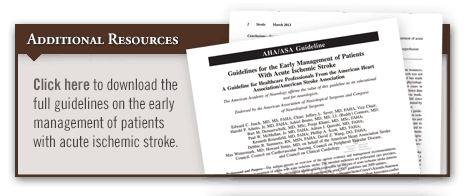In 2013, the American Heart Association (AHA) and American Stroke Association (ASA) updated guidelines on the early management of acute ischemic stroke, representing the first update to these recommendations since 2007. Several substantial changes were incorporated into the new guidelines. The new document incorporates an AHA/ASA science advisory from 2009 that recommends the use of tissue plasminogen activator in appropriate patients who present to hospitals within 3.0 to 4.5 hours of symptom onset. It’s also recommended that door-to-needle times be less than 60 minutes for patients who are eligible for thrombolysis.
The FDA approvals of the Trevo Retriever (Concentric Medical) system and Solitaire Flow Restoration (Covidien) device were significant new advances that were addressed in the guideline update. These devices are alternatives to coil retrievers and offer clinicians a new mechanical approach for restoring blood flow to occluded arteries. The updated AHA/ASA guidelines recommend that the Trevo Retriever system and Solitaire Flow Restoration device be the preferential choice when mechanical thrombectomy is pursued.
Since 2007, several studies have focused on the use of decompressive surgery for malignant cerebral edema. These new data led to the recommendation that this approach be considered for acute ischemic stroke patients with large infarcts because of its potential life-saving capabilities and because it can restore a reasonable quality of life in appropriately selected patients.
Implications for Emergency Medicine & Stroke
Emergency physicians and nurses should be intimately integrated into the care of stroke patients. The AHA/ASA guideline recognizes that the saying “time is brain” is more critical than ever before. Timely, definitive care must be delivered in the ED. Emergency physicians need to be involved in moving stroke patients through the healthcare system as quickly as possible. Leaders in EDs should review the updated AHA/ASA guidelines with their stroke teams and extract the best practices as they apply to their particular institution.
Important Caveats to Stroke Management
It should be noted, however, that the current recommendations may not be applicable if a hospital doesn’t have a catheter laboratory. Furthermore, hospitals that don’t have a stroke team should look into telemedicine to deliver stroke care with the help of off-site neurologists.
Emergency providers should recognize when care needs exceed their capacity to deliver optimal care and work with regional or comprehensive stroke centers to efficiently identify patients who may need to be transferred to receive appropriate care. The AHA/ASA guideline update recognizes the importance of having ED physicians at the bedside versus only advocating to stroke champions. Emergency physicians are encouraged to be engaged in acute stroke care because their unique skill set can make a profound difference in patient outcomes.




 admin
admin